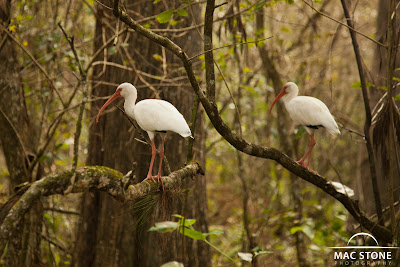A peregrine falcon must have scared this flock of shorebirds in Florida Bay. The sound they made while flying was incredible.
Every year National Audubon conducts bird counts in each state to assess the health and status of bird populations around the country. From December 14th through January 5th of 2012, thousands of volunteers selflessly dedicate their time to slog, hike, boat, and paddle with guide books, binoculars, and checklists in hand. For many, this has become a family tradition as it's a great excuse to get outside and see some incredible wildlife while contributing to conservation.
Rafael uses a scope to identify shorebirds in the distance at one of the keys in central Florida Bay
 To be honest, I was a little nervous about my first count. I know my wading birds and raptors fairly well but identifying shorebirds and songbirds is so frustratingly difficult for me that I feel I'm a disgrace to the Audubon name. My redemption would be found in calling out the bright pink roseate spoonbills flying against the stark blue sky. Fortunately, I was assigned to be captain of a boat with two of the most knowledgable birders and naturalists I've ever met. Rafael Galvez and Michelle Davis just finished a bird count on the Dry Tortugas two days prior and politely assured me all I would have to do is steer the boat. Huge sigh of relief.
To be honest, I was a little nervous about my first count. I know my wading birds and raptors fairly well but identifying shorebirds and songbirds is so frustratingly difficult for me that I feel I'm a disgrace to the Audubon name. My redemption would be found in calling out the bright pink roseate spoonbills flying against the stark blue sky. Fortunately, I was assigned to be captain of a boat with two of the most knowledgable birders and naturalists I've ever met. Rafael Galvez and Michelle Davis just finished a bird count on the Dry Tortugas two days prior and politely assured me all I would have to do is steer the boat. Huge sigh of relief.The Tavernier Science Center hosted the bird count of Florida Bay and the Upper Keys. With a team of 15 birders, biologists, enthusiasts, and naturalists we scoured the region from 6:30 AM until 6:00 PM. We identified 95 species and counted 11,164 individuals!
Semipalmated sandpiper, as close as I could get with a 400mm lens.
 Part of the purpose of the bird count is to also help determine the range and migratory behaviors of certain birds. Our team spent a great deal of time just trying to verify the identity and number of semipalmated sandpipers. Florida Bay, it turns out, is the only place where these birds don't continue to fly south for the winter. Florida Bay is also the only place to find prairie warblers with a distinctive orange coloration in their faces.
Part of the purpose of the bird count is to also help determine the range and migratory behaviors of certain birds. Our team spent a great deal of time just trying to verify the identity and number of semipalmated sandpipers. Florida Bay, it turns out, is the only place where these birds don't continue to fly south for the winter. Florida Bay is also the only place to find prairie warblers with a distinctive orange coloration in their faces.The hardest groups to count, however, were the floating mats of cormorants. Any guesses as to how many are in the photo above?
After participating in my first bird count, I can see how it attracts so many volunteers. My group alone accounted for 5,640 birds, which is an incredible sight to behold in an 11 hour period. I would highly recommend the Christmas Bird Count to anyone looking to spend a day outside for a cause certainly worth supporting. I'm definitely going to make it an annual tradition, wherever I might be.




























